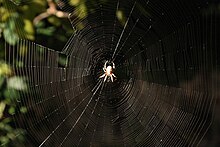Araneus diadematus: Difference between revisions
+ video |
|||
| Line 55: | Line 55: | ||
*[http://www.flickr.com/photos/gemineo/2822701450/ An HDR macro picture] at flickr.com |
*[http://www.flickr.com/photos/gemineo/2822701450/ An HDR macro picture] at flickr.com |
||
* [http://naturdata.com/index.php?option=com_species&spid=13051:Araneus-diadematus&Itemid=66 Araneus diadematus - information from Portugal] - Naturdata |
* [http://naturdata.com/index.php?option=com_species&spid=13051:Araneus-diadematus&Itemid=66 Araneus diadematus - information from Portugal] - Naturdata |
||
*[http://www.rebekahesme.com/2011/10/macro-photography.html/ Macro Photographs] Macro (close up) shots of the Araneus diadematus. |
|||
[[Category:Araneidae]] |
[[Category:Araneidae]] |
||
Revision as of 19:24, 8 October 2011
| Araneus diadematus | |
|---|---|

| |
| Female waiting for prey. Notice the signal thread | |

| |
| Male | |
| Scientific classification | |
| Kingdom: | |
| Phylum: | |
| Class: | |
| Order: | |
| Suborder: | |
| Family: | |
| Genus: | |
| Species: | A. diadematus
|
| Binomial name | |
| Araneus diadematus | |


The European garden spider, diadem spider, cross spider, or cross orbweaver[2] (Araneus diadematus) is a very common and well-known orb-weaver spider in Europe and parts of North America, in a range extending from New England and the Southeast to California and the northwestern United States and adjacent parts of southern Canada.[3]
Individual spiders' colouring can range from extremely light yellow to very dark grey, but all European garden spiders have mottled markings across the back with five or more large white dots forming a cross. The white dots result from cells that are filled with guanine, which is a byproduct of protein metabolism.[4]
Adult females range in length from 6.5 to 20 mm (0.26 to 0.79 in) while males range from 5.5 to 13 mm (0.22 to 0.51 in).[5]
The third pair of legs of garden spiders are specialized for assisting in the spinning of orb webs. These spiders also use them to move around on their web without getting stuck. These legs are useful only in the web; while on the ground, these legs are of little value.[citation needed]
Since this tends to be a passive animal, it is difficult to provoke to bite—but if it does, the bite is just slightly unpleasant and completely harmless to humans.[3]
The webs are built by the larger females who usually lie head down on the web, or in a nearby leaf (with a signal thread attached to a leg), waiting for prey to get entangled in the web. The prey is then quickly captured and wrapped in silk before being eaten. Orb spiders are said to eat their webs each night along with many of the small insects stuck to it. They have been observed doing this within a couple of minutes. A new web is then spun in the morning.[3]
The much smaller male will approach the female cautiously to mate. If not careful, he could end up being eaten by her.[6]
See also
References
- ^ Nikita J. Kluge (2007). "Case 3371. Araneidae Clerck, 1758, Araneus Clerck, 1758 and Tegenaria Latreille, 1804 (Arachnida, Araneae): proposed conservation" (PDF). Bulletin of Zoological Nomenclature. 64 (1): 15–18.
- ^ Cross Orbweaver, BugGuide
- ^ a b c Cross Spider, Washington NatureMapping Project
- ^ Rainer F. Foelix (1992). Biologie der Spinnen (in German). Stuttgart: Thieme. ISBN 3135758028.
{{cite book}}: Unknown parameter|trans_title=ignored (|trans-title=suggested) (help) - ^ Cross Orbweaver, Penn State Entomology
- ^ European Garden Spider, Down Garden Services
External links
- Extreme close-up showing eyes from Adrian Lozinski's Photography Website
- Araneaus diadematus at Nick's Spiders of Britain and Europe
- European Garden Spider at Hans and Hania's Garden Safari
- European orb weavers at Spiders of NW-Europe
- World Spider Catalog
- An HDR macro picture at flickr.com
- Araneus diadematus - information from Portugal - Naturdata
- Macro Photographs Macro (close up) shots of the Araneus diadematus.
